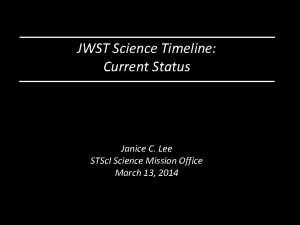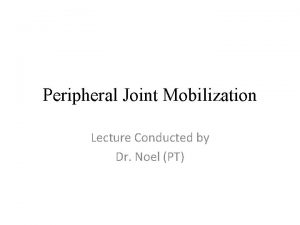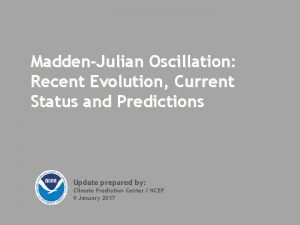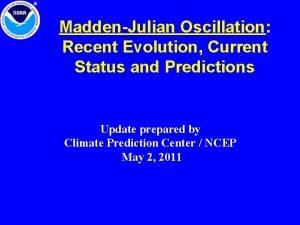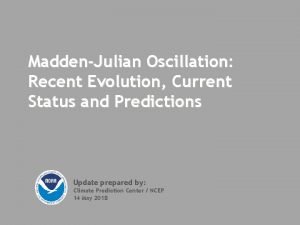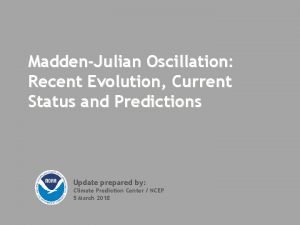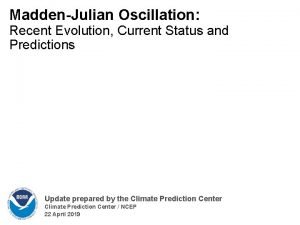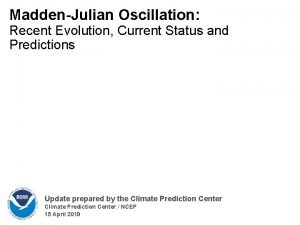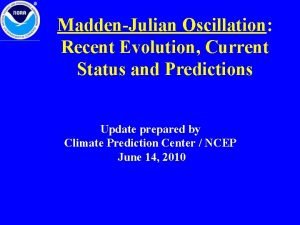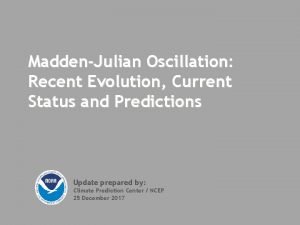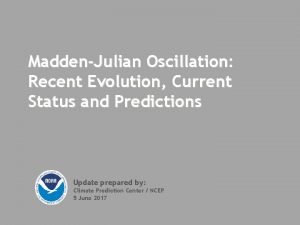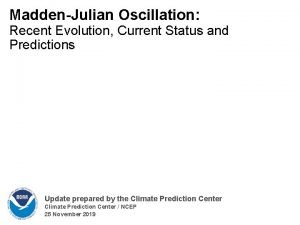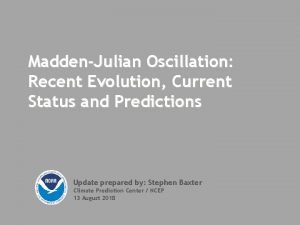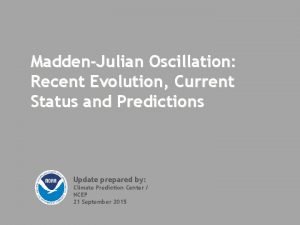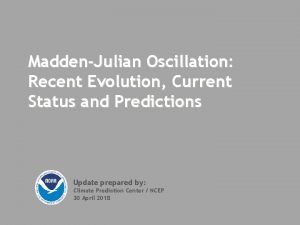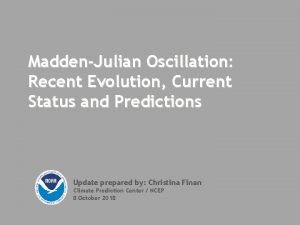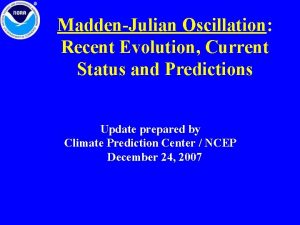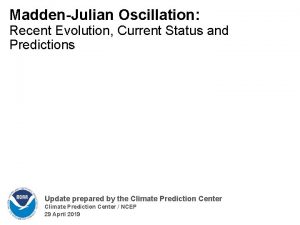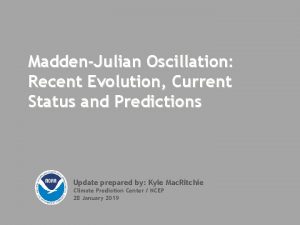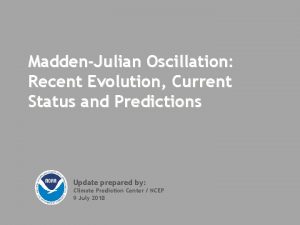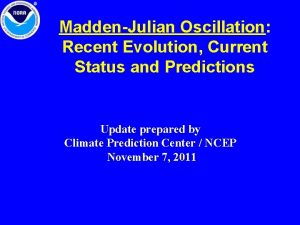MaddenJulian Oscillation Recent Evolution Current Status and Predictions





















- Slides: 21

Madden-Julian Oscillation: Recent Evolution, Current Status and Predictions Update prepared by: Kyle Mac. Ritchie Climate Prediction Center / NCEP 26 March 2018

Outline Overview Recent Evolution and Current Conditions MJO Index Information MJO Index Forecasts MJO Composites

Overview The MJO weakened over the past week and is now within the unit circle. The GEFS forecast suggests that it will re-emerge over the Western Pacific during the next week. An area of enhanced convection over the Maritime Continent and northern Australia is associated with tropical cyclone activity. Anomalously strong upper-level winds that stretch from Hawaii to California are associated with a plume of moisture that has been in place during the past week. Additional potential impacts across the global tropics and a discussion for the U. S. are available at: http: //www. cpc. ncep. noaa. gov/products/precip/CWlink/ghazards/index. php

850 -h. Pa Vector Wind Anomalies (m s-1) Note that shading denotes the zonal wind anomaly Blue shades: Easterly anomalies Red shades: Westerly anomalies Weak winds over the western Indian Ocean reflect weak MJO conditions. Anomalous easterlies are present along the equator, consistent with La Niña. Mid-latitude waves dominate the northern Pacific and Atlantic flows.

850 -h. Pa Zonal Wind Anomalies (m s-1) Westerly anomalies (orange/red shading) represent anomalous west-to-east flow Easterly anomalies (blue shading) represent anomalous east-to-west flow Low frequency anomalous easterlies that had been present since September reversed sign during February. During October and early November, a robust MJO event developed, with eastward propagation of westerly and easterly anomalies. This event weakened in early to mid-November. A new MJO event became organized in December, propagating from the Indian Ocean to the Pacific. The signal crossed the Western Hemisphere in late December, re-emerging over the Indian Ocean in early January. The signal continued to propagate eastward, moving into the central and eastern Pacific and began weakening during mid-February. Most recently, stationary easterly anomalies are noted between 120 W and the Date Line.

OLR Anomalies – Past 30 days Drier-than-normal conditions, positive OLR anomalies (yellow/red shading) Wetter-than-normal conditions, negative OLR anomalies (blue shading) During mid-late February, a zonally oriented band of positive OLR anomalies straddling 10 S stretched from Tanzania across the Indian Ocean, Indonesia, and the Solomon Islands. Positive OLR anomalies over the southern Indian Ocean and Maritime Continent weakened substantially from late February into early March. During the same period, positive OLR anomalies strengthened over the central Pacific associated with anomalously low cloud cover and suppressed convection. The extended region of negative OLR anomalies stretching from Hawaii to the west coast of North America is consistent with a subtropical moisture feed that has been in place since early March. Enhanced convection over the Maritime Continent and northern Australia is associated with tropical cyclone activity.

Outgoing Longwave Radiation (OLR) Anomalies (7. 5ºS - 7. 5ºN) Drier-than-normal conditions, positive OLR anomalies (yellow/red shading) Wetter-than-normal conditions, negative OLR anomalies (blue shading) An active MJO formed in early October and circumnavigated the globe by early November. Another MJO event developed in late November over the eastern Indian Ocean and Maritime Continent that was able to briefly disrupt the La Niña convective suppression near the Date Line in mid-December. The MJO re-emerged in the Indian Ocean at the end of December and strengthened as it shifted east toward the Date Line. This led to a reversal of the canonical La Niña convective suppression signal in early February. This MJO signal circumnavigated the global tropics during February, reaching the Indian Ocean and weakening substantially by mid-March.

200 -h. Pa Velocity Potential Anomalies (5ºS - 5ºN) Positive anomalies (brown shading) indicate unfavorable conditions for precipitation Negative anomalies (green shading) indicate favorable conditions for precipitation An MJO event developed near the Maritime Continent during early October with strong anomalous upperlevel winds near 120 E. The signal circumnavigated the global tropics and weakened about 30 days later. MJO activity renewed in November. The intraseasonal signal associated with this MJO event was weaker than the previous episode due to destructive interference from an equatorial Rossby wave. The signal destructively interfered with the base state through the end of December, crossing the Western Hemisphere into the Indian Ocean during the beginning of January. This MJO event further intensified during January and early February, leading to another period of destructive interference with the ENSO state, prior to weakening during March.

IR Temperatures (K) / 200 -h. Pa Velocity Potential Anomalies THIS SLIDE NOT UPDATED A noisy Wave-1 pattern is present with enhanced (suppressed) convection generally over the Eastern (Western) Hemisphere. The large area of enhanced convection over the Maritime Continent is related to recent tropical cyclone activity. Positive anomalies (brown contours) indicate unfavorable conditions for precipitation Negative anomalies (green contours) indicate favorable conditions for precipitation

200 -h. Pa Vector Wind Anomalies (m s-1) Note that shading denotes the zonal wind anomaly Blue shades: Easterly anomalies Red shades: Westerly anomalies A bifurcating jet stream is depicted over the central Pacific, with cross-equatorial flow indicated downstream over the eastern Pacific. Anomalous westerlies that stretch from Hawaii to California are part of a moisture feed that has been in place over the past couple of weeks. T D R C

200 -h. Pa Zonal Wind Anomalies (m s-1) Westerly anomalies (orange/red shading) represent anomalous west-to-east flow Easterly anomalies (blue shading) represent anomalous east-to-west flow Low-frequency anomalous westerlies remained in place east of 140 E starting in October, with the exception of a brief period of easterlies in late October. There is also some recent evidence of easterlies over the far Eastern Hemisphere over the last week or so that appear to have extratropical sourcing. In mid-December anomalous easterlies developed east of the Date Line, replacing the westerly anomalies that had been generally present since October. Strong anomalous westerlies that formed in early January just west of the Date Line propagated eastward, consistent with a strong MJO event during this period. More recently, relatively stationary anomalous westerlies have dominated from 100 E across the Date Line to 100 W.

Weekly Heat Content Evolution in the Equatorial Pacific Oceanic Kelvin waves have alternating warm and cold phases. The warm phase is indicated by dashed lines. Downwelling and warming occur in the leading portion of a Kelvin wave, and upwelling and cooling occur in the trailing portion. Negative upper-ocean heat content anomalies persisted in the central and eastern Pacific from August-December. A downwelling Kelvin wave associated with the intraseasonal signal weakened the negative anomalies across the east-central Pacific during late January and early February. Another downwelling Kelvin wave is leading to highly positive, eastward-propagating anomalies near and east of the Date Line.

MJO Index -- Information The MJO index illustrated on the next several slides is the CPC version of the Wheeler and Hendon index (2004, hereafter WH 2004). Wheeler M. and H. Hendon, 2004: An All-Season Real-Time Multivariate MJO Index: Development of an Index for Monitoring and Prediction, Monthly Weather Review, 132, 1917 -1932. The methodology is very similar to that described in WH 2004 but does not include the linear removal of ENSO variability associated with a sea surface temperature index. The methodology is consistent with that outlined by the U. S. CLIVAR MJO Working Group. Gottschalck et al. 2010: A Framework for Assessing Operational Madden-Julian Oscillation Forecasts: A CLIVAR MJO Working Group Project, Bull. Amer. Met. Soc. , 91, 1247 -1258. The index is based on a combined Empirical Orthogonal Function (EOF) analysis using fields of near-equatorially-averaged 850 -h. Pa and 200 -h. Pa zonal wind and outgoing longwave radiation (OLR).

MJO Index – Recent Evolution The axes (RMM 1 and RMM 2) represent daily values of the principal components from the two leading modes The triangular areas indicate the location of the enhanced phase of the MJO Counter-clockwise motion is indicative of eastward propagation. Large dot most recent observation. Distance from the origin is proportional to MJO strength Line colors distinguish different months The RMM index suggests that the MJO has weakened over the past week and is now in an inactive state.

MJO Index – Historical Daily Time Series Time series of daily MJO index amplitude for the last few years. Plot puts current MJO activity in recent historical context.

GFS Ensemble (GEFS) MJO Forecast RMM 1 and RMM 2 values for the most recent 40 days and forecasts from the GFS ensemble system (GEFS) for the next 15 days light gray shading: 90% of forecasts dark gray shading: 50% of forecasts The GEFS suggests that the MJO will reemerge over the Western Pacific during the Week-1 period. Yellow Lines – 20 Individual Members Green Line – Ensemble Mean

Ensemble GFS (GEFS) MJO Forecast Spatial map of OLR anomalies for the next 15 days The GEFS plot of MJO related OLR anomalies is unavailable at this time. OLR anomalies associated with the MJO based on the GEFS show a strengthening MJO signal, with the suppressed convective phase forecast to move from the eastern Indian Ocean across the Maritime Continent. Figures below show MJO associated OLR anomalies only (reconstructed from RMM 1 and RMM 2) and do not include contributions from other modes (i. e. , ENSO, monsoons, etc. ) Time-longitude section of (7. 5°S-7. 5°N) OLR anomalies - last 180 days and for the next 15 days The GEFS plot of MJO related OLR anomalies is unavailable at this time.

Constructed Analog (CA) MJO Forecast Spatial map of OLR anomalies for the next 15 days Figures below show MJO associated OLR anomalies only (reconstructed from RMM 1 and RMM 2) and do not include contributions from other modes (i. e. , ENSO, monsoons, etc. ) Time-longitude section of (7. 5°S-7. 5°N) OLR anomalies - last 180 days and for the next 15 days The GEFS plot of MJO related OLR anomalies is unavailable at this time. The constructed analog predicts a slowly propagating signal, with rapid weakening of the signal expected during Week-2.

MJO Composites – Global Tropics 850 -h. Pa Velocity Potential and Wind Anomalies (Nov - Mar) Precipitation Anomalies (Nov - Mar)

U. S. MJO Composites – Temperature Left hand side plots show temperature anomalies by MJO phase for MJO events that have occurred over the three month period in the historical record. Blue (orange) shades show negative (positive) anomalies respectively. Right hand side plots show a measure of significance for the left hand side anomalies. Purple shades indicate areas in which the anomalies are significant at the 95% or better confidence level. Zhou et al. (2011): A composite study of the MJO influence on the surface air temperature and precipitation over the Continental United States, Climate Dynamics, 1 -13, doi: 10. 1007/s 00382 -011 -1001 -9 http: //www. cpc. ncep. noaa. gov/products/precip/CWlink/MJO/mjo. shtml

U. S. MJO Composites – Precipitation Left hand side plots show precipitation anomalies by MJO phase for MJO events that have occurred over the three month period in the historical record. Brown (green) shades show negative (positive) anomalies respectively. Right hand side plots show a measure of significance for the left hand side anomalies. Purple shades indicate areas in which the anomalies are significant at the 95% or better confidence level. Zhou et al. (2011): A composite study of the MJO influence on the surface air temperature and precipitation over the Continental United States, Climate Dynamics, 1 -13, doi: 10. 1007/s 00382 -011 -1001 -9 http: //www. cpc. ncep. noaa. gov/products/precip/CWlink/MJO/mjo. shtml
 Line currents
Line currents Line current and phase current
Line current and phase current Energy band diagram of pn junction diode
Energy band diagram of pn junction diode Lesson 4 three-phase motors
Lesson 4 three-phase motors Drift current density unit
Drift current density unit Ceramic composition resistors
Ceramic composition resistors In a ∆-connected source feeding a y-connected load
In a ∆-connected source feeding a y-connected load Holding current and latching current
Holding current and latching current Drift current and diffusion current in semiconductor
Drift current and diffusion current in semiconductor Gyration in size separation
Gyration in size separation Drain current in the constant-current region increases when
Drain current in the constant-current region increases when In alternators the welding current is produced on the ____.
In alternators the welding current is produced on the ____. Touch current vs leakage current
Touch current vs leakage current Mesh current method with current source
Mesh current method with current source Current program status register is
Current program status register is Scientist project
Scientist project Current status of buddhism
Current status of buddhism What is periodic motion definition
What is periodic motion definition Non-thrust oscillation techniques
Non-thrust oscillation techniques Peripheral mobilization
Peripheral mobilization Dynamics
Dynamics Sustained translatory joint play techniques
Sustained translatory joint play techniques















